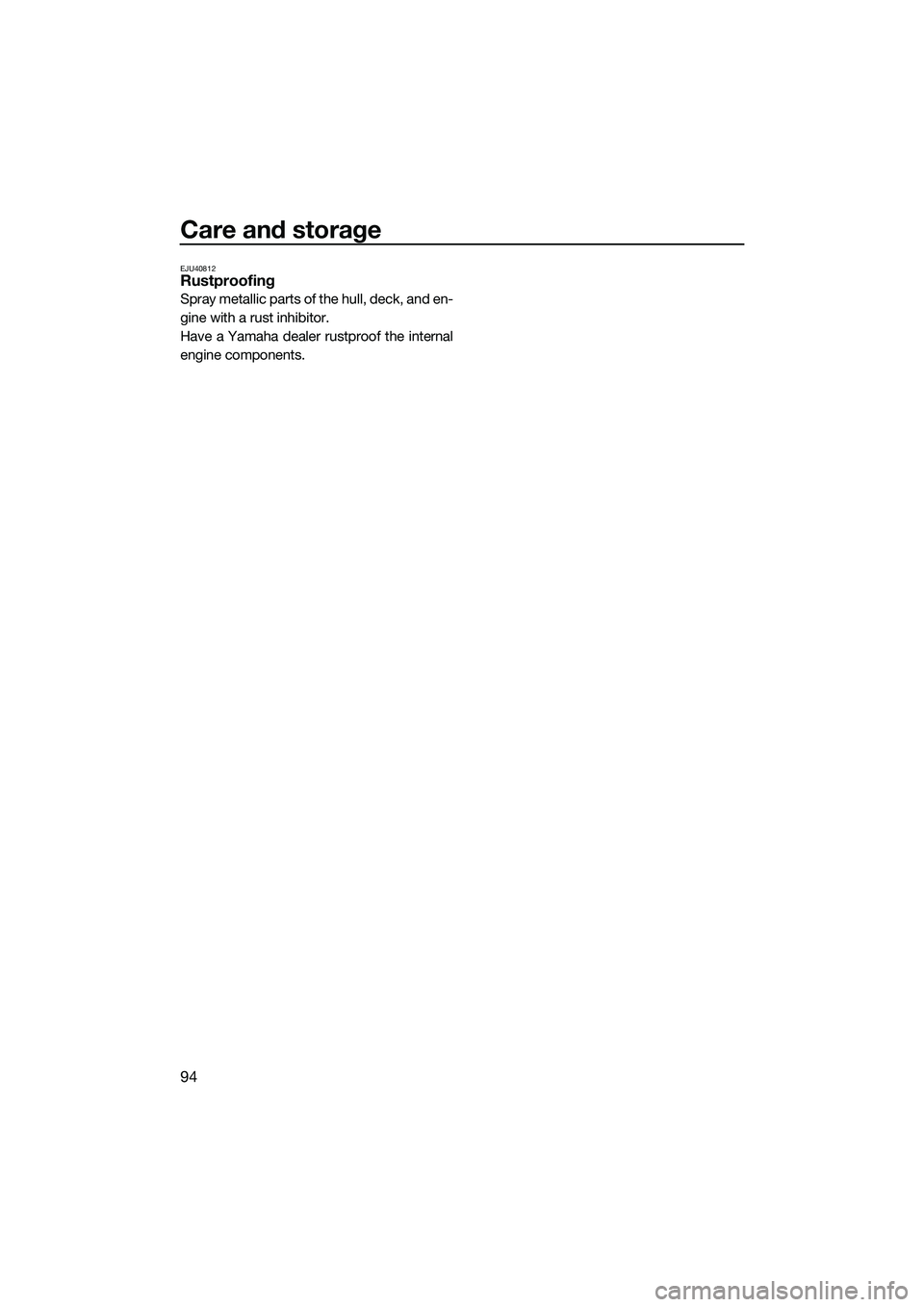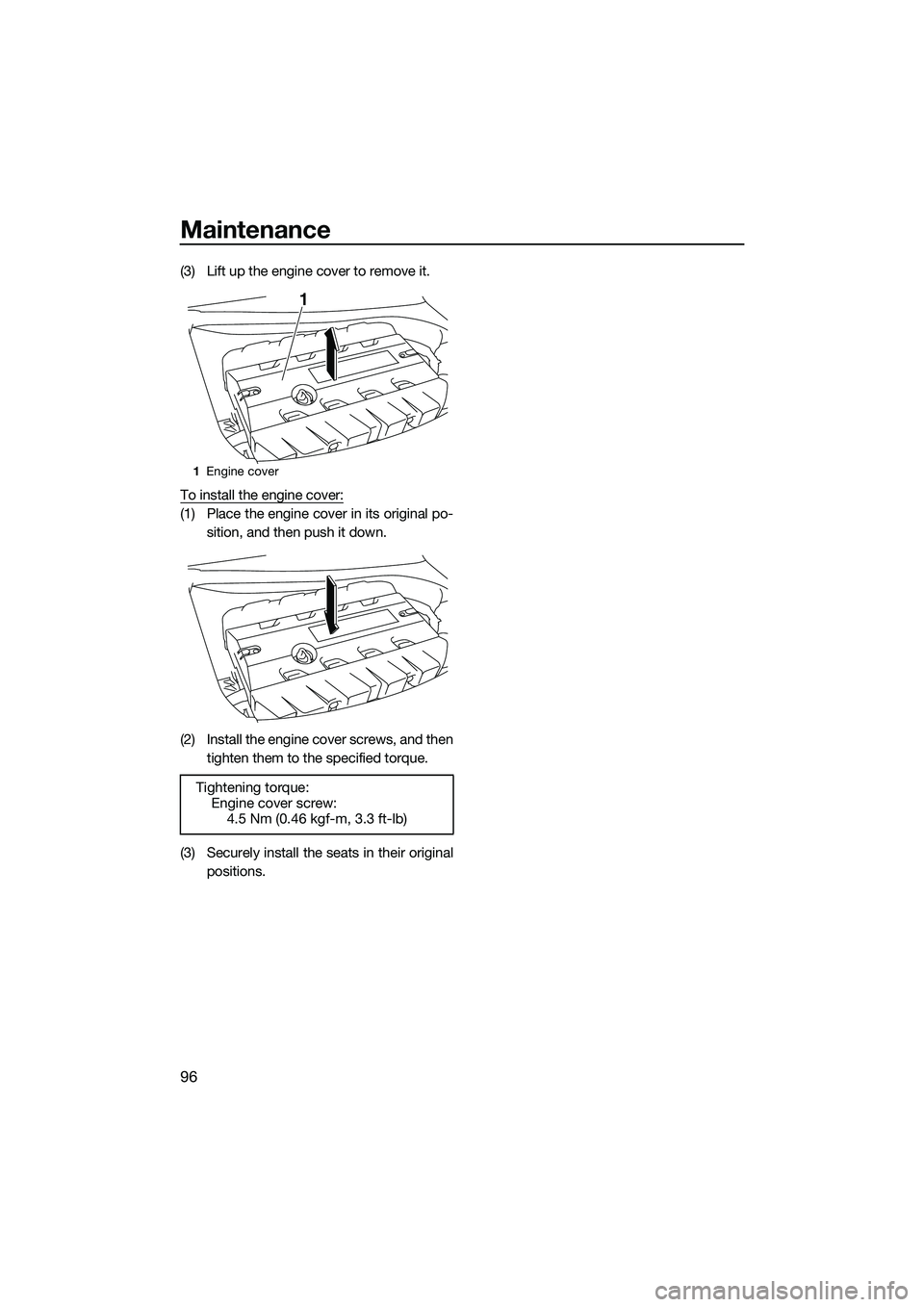Page 97 of 118
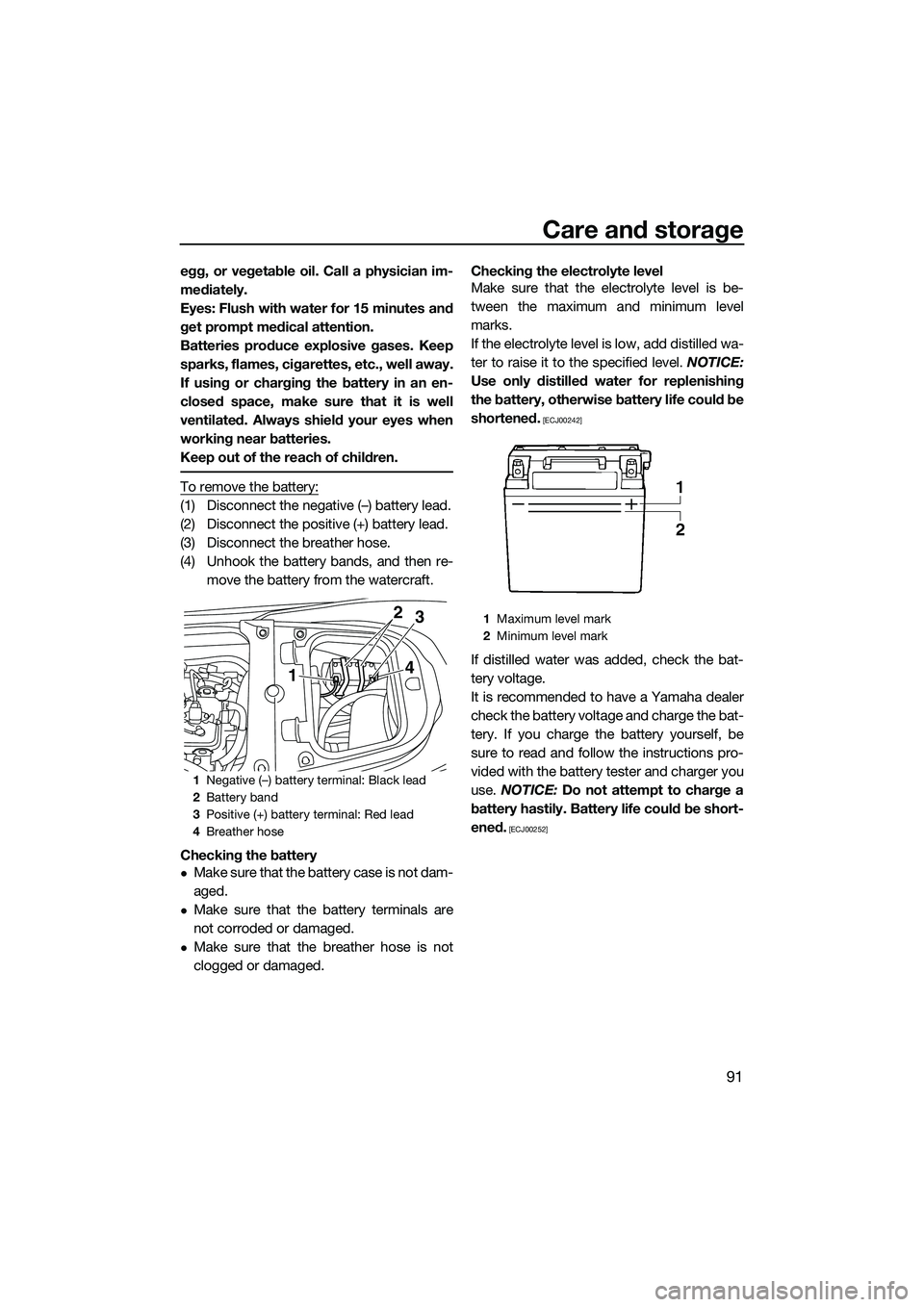
Care and storage
91
egg, or vegetable oil. Call a physician im-
mediately.
Eyes: Flush with water for 15 minutes and
get prompt medical attention.
Batteries produce explosive gases. Keep
sparks, flames, cigarettes, etc., well away.
If using or charging the battery in an en-
closed space, make sure that it is well
ventilated. Always shield your eyes when
working near batteries.
Keep out of the reach of children.
To remove the battery:
(1) Disconnect the negative (–) battery lead.
(2) Disconnect the positive (+) battery lead.
(3) Disconnect the breather hose.
(4) Unhook the battery bands, and then re-move the battery from the watercraft.
Checking the battery
Make sure that the battery case is not dam-
aged.
Make sure that the battery terminals are
not corroded or damaged.
Make sure that the breather hose is not
clogged or damaged. Checking the electrolyte level
Make sure that the electrolyte level is be-
tween the maximum and minimum level
marks.
If the electrolyte level is low, add distilled wa-
ter to raise it to the specified level.
NOTICE:
Use only distilled water for replenishing
the battery, otherwise battery life could be
shortened.
[ECJ00242]
If distilled water was added, check the bat-
tery voltage.
It is recommended to have a Yamaha dealer
check the battery voltage and charge the bat-
tery. If you charge the battery yourself, be
sure to read and follow the instructions pro-
vided with the battery tester and charger you
use. NOTICE: Do not attempt to charge a
battery hastily. Battery life could be short-
ened.
[ECJ00252]
1 Negative (–) battery terminal: Black lead
2 Battery band
3 Positive (+) battery terminal: Red lead
4 Breather hose
143
2
1
Maximum level mark
2 Minimum level mark
UF3J70E0.book Page 91 Wednesd ay, October 9, 2013 2:07 PM
Page 98 of 118
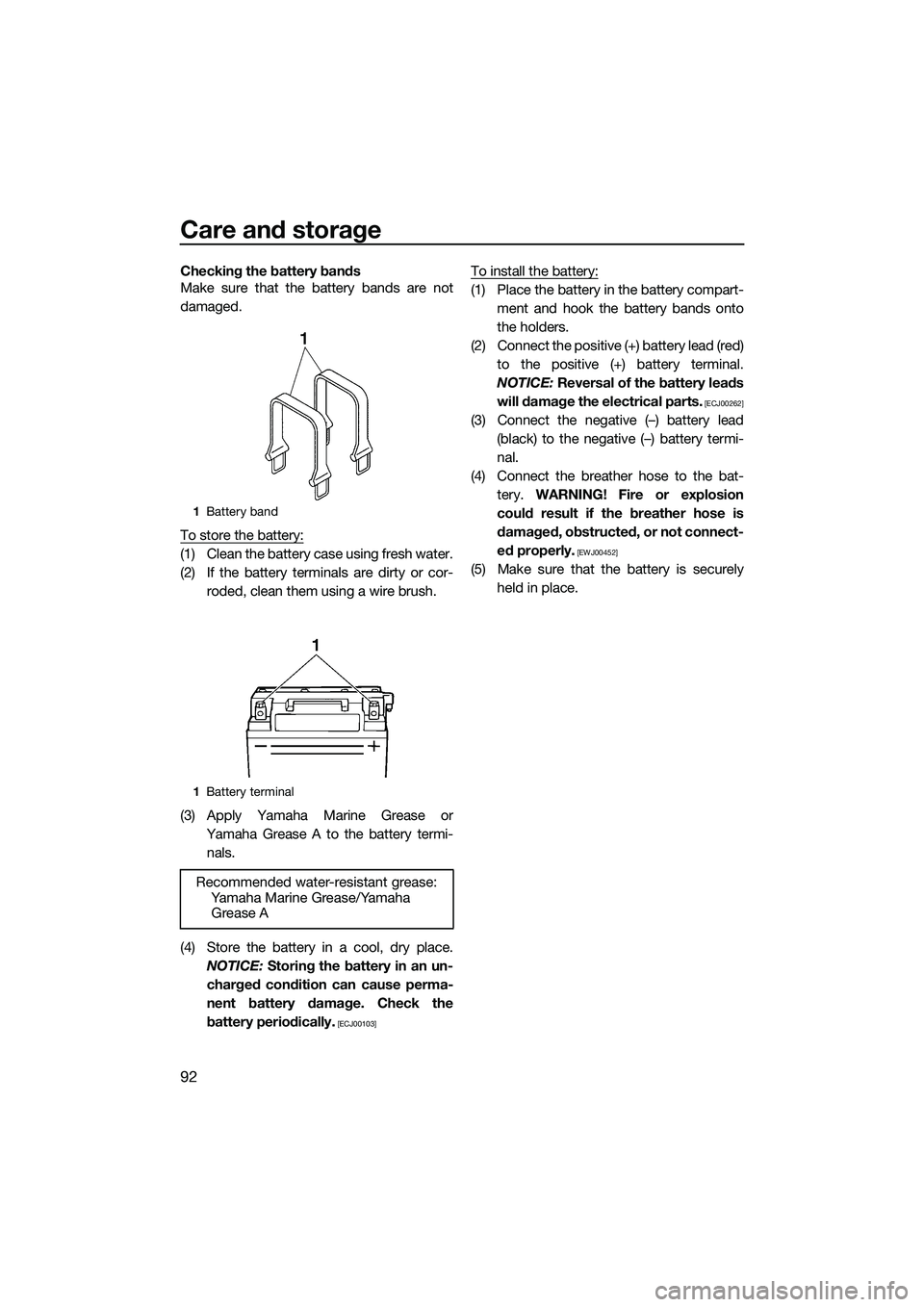
Care and storage
92
Checking the battery bands
Make sure that the battery bands are not
damaged.
To store the battery:
(1) Clean the battery case using fresh water.
(2) If the battery terminals are dirty or cor-roded, clean them using a wire brush.
(3) Apply Yamaha Marine Grease or Yamaha Grease A to the battery termi-nals.
(4) Store the battery in a cool, dry place. NOTICE: Storing the battery in an un-
charged condition can cause perma-
nent battery damage. Check the
battery periodically.
[ECJ00103]
To install the battery:
(1) Place the battery in the battery compart- ment and hook the battery bands onto
the holders.
(2) Connect the positive (+) battery lead (red) to the positive (+) battery terminal.
NOTICE: Reversal of the battery leads
will damage the electrical parts.
[ECJ00262]
(3) Connect the negative (–) battery lead (black) to the negative (–) battery termi-
nal.
(4) Connect the breather hose to the bat- tery. WARNING! Fire or explosion
could result if the breather hose is
damaged, obstructed, or not connect-
ed properly.
[EWJ00452]
(5) Make sure that the battery is securely held in place.
1Battery band
1 Battery terminal
Recommended water-resistant grease:
Yamaha Marine Grease/Yamaha
Grease A
UF3J70E0.book Page 92 Wednesd ay, October 9, 2013 2:07 PM
Page 99 of 118
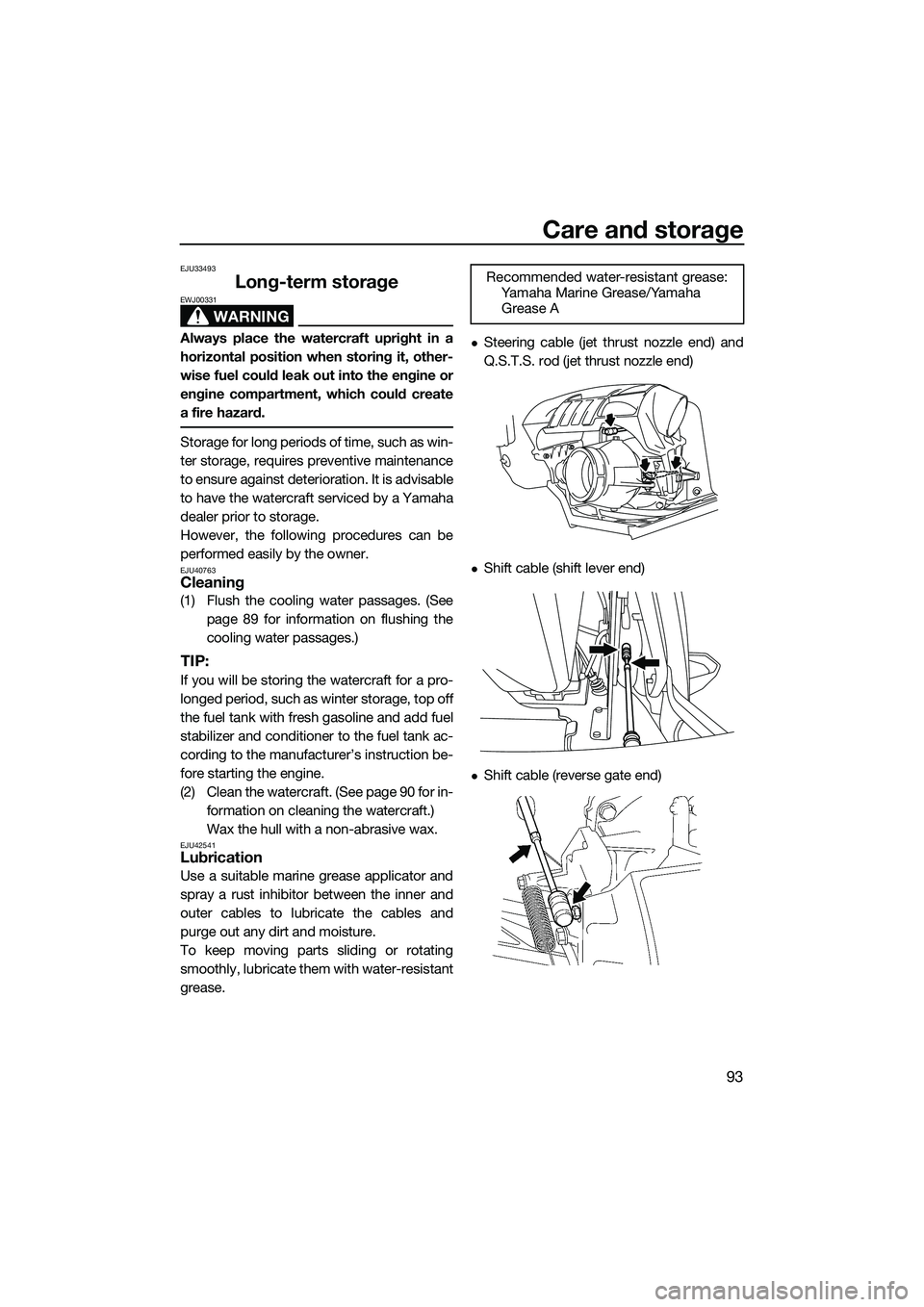
Care and storage
93
EJU33493
Long-term storage
WARNING
EWJ00331
Always place the watercraft upright in a
horizontal position when storing it, other-
wise fuel could leak out into the engine or
engine compartment, which could create
a fire hazard.
Storage for long periods of time, such as win-
ter storage, requires preventive maintenance
to ensure against deterioration. It is advisable
to have the watercraft serviced by a Yamaha
dealer prior to storage.
However, the following procedures can be
performed easily by the owner.
EJU40763Cleaning
(1) Flush the cooling water passages. (Seepage 89 for information on flushing the
cooling water passages.)
TIP:
If you will be storing the watercraft for a pro-
longed period, such as winter storage, top off
the fuel tank with fresh gasoline and add fuel
stabilizer and conditioner to the fuel tank ac-
cording to the manufacturer’s instruction be-
fore starting the engine.
(2) Clean the watercraft. (See page 90 for in-formation on cleaning the watercraft.)
Wax the hull with a non-abrasive wax.
EJU42541Lubrication
Use a suitable marine grease applicator and
spray a rust inhibitor between the inner and
outer cables to lubricate the cables and
purge out any dirt and moisture.
To keep moving parts sliding or rotating
smoothly, lubricate them with water-resistant
grease.
Steering cable (jet thrust nozzle end) and
Q.S.T.S. rod (jet thrust nozzle end)
Shift cable (shift lever end)
Shift cable (reverse gate end)Recommended water-resistant grease:
Yamaha Marine Grease/Yamaha
Grease A
UF3J70E0.book Page 93 Wednesd ay, October 9, 2013 2:07 PM
Page 100 of 118
Care and storage
94
EJU40812Rustproofing
Spray metallic parts of the hull, deck, and en-
gine with a rust inhibitor.
Have a Yamaha dealer rustproof the internal
engine components.
UF3J70E0.book Page 94 Wednesday, October 9, 2013 2:07 PM
Page 101 of 118

Maintenance
95
EJU33769
Maintenance
Periodic checks and lubrication will keep
your watercraft in the safest and most effi-
cient condition possible. Therefore, make
sure to carry out the periodic maintenance.
Safety is an obligation of the watercraft own-
er. Proper maintenance must be carried out
to keep the exhaust emission and sound lev-
els within the regulated limits. The most im-
portant points of watercraft inspection and
lubrication are explained on the following
pages.
See a Yamaha dealer for genuine Yamaha re-
placement parts and optional accessories
designed for your watercraft.
Remember, failures that are the result of the
installation of parts or accessories which are
not qualitatively equivalent to genuine
Yamaha parts are not covered by the limited warranty.
Maintenance, replacement, or repair of
the emission control devices and system
may be performed by any marine SI engine
repair establishment or individual. War-
ranty repair, however, must be performed
at an authorized Yamaha marine dealer-
ship.
WARNING
EWJ00312
Be sure to turn off the engine when you
perform maintenance unless otherwise
specified. If you are not familiar with ma-
chine servicing, this work should be done
by a Yamaha dealer or other qualified me-
chanic.
EJU33803Tool kit
A tool kit is included with this watercraft.
Place the tool kit in a waterproof bag and al- ways carry it with you whenever you use the
watercraft.
EJU42021Removing and installing the engine
cover
The engine cover is removable.
To remove the engine cover:
(1) Remove the seats. (See page 49 for seat
removal and installation procedures.)
(2) Remove the engine cover screws.
1 Tool bag
2 Screwdriver
3 Garden hose adapter
4 10/12 mm box wrench
5 Pliers
6 10/12 mm open-end wrench
1 Engine cover screw
1
UF3J70E0.book Page 95 Wednesd ay, October 9, 2013 2:07 PM
Page 102 of 118
Maintenance
96
(3) Lift up the engine cover to remove it.
To install the engine cover:
(1) Place the engine cover in its original po-sition, and then push it down.
(2) Install the engine cover screws, and then tighten them to the specified torque.
(3) Securely install the seats in their original positions.
1Engine cover
Tightening torque:
Engine cover screw:
4.5 Nm (0.46 kgf-m, 3.3 ft-lb)
1
UF3J70E0.book Page 96 Wednesd ay, October 9, 2013 2:07 PM
Page 103 of 118

Maintenance
97
EJU43100Periodic maintenance chart
The periodic maintenance chart gives general guidelines for periodic maintenance. Have a
Yamaha dealer perform the checks in the following chart. However, maintenance may need to be performed more frequently depending on your operating conditions. If you have any
questions, consult a Yamaha dealer.
This “ √” mark indicates items to be checked and serviced by a Yamaha dealer.
Item OperationInitial Thereafter every
Page
10 hours 50 hours
or 12
months *1 100
hours or 12
months *1 200
hours or 24
months *1
Fuel line Check fuel hoses and
clamps
√
—
Fuel filler cap/Wa-
ter separator Check O-rings for cracks
and deformation
√
—
Fuel tank Check installation and
straps
√
—
Water inlet strainer Check for clogs and dam-
age
√
—
Cooling water hos-
es Check for damage and
leakage, and check
clamps
√
—
Engine oil Replace √√ 99
Oil filter Replace √99
Intermediate hous-
ing Lubricate
√—
Spark plugs Check √√ —
Battery Check specific gravity of
electrolyte, terminals,
bands, and breather hose √
—
Battery leads Check terminals √—
Steering master Check operation and for
looseness
√√
—
Steering cable Check exterior and con-
nections, and lubricate
√
—
Q.S.T.S. cable Check exterior and con-
nections, and lubricate
√
—
Q.S.T.S. converter
and rod Check exterior and con-
nections, and lubricate
√√
—
Shift lever Check exterior and con-
nections, and lubricate
√
—
Shift cable and re-
verse gate Check exterior and con-
nections, and lubricate
√
—
UF3J70E0.book Page 97 Wednesd ay, October 9, 2013 2:07 PM
Page 104 of 118

Maintenance
98
*1: Whichever comes first.
*2: Check every 200 hours.
Perform the pre-operation checks and post-operation checks before performing periodic
maintenance.
Air filter elementCheck for damage and
dirt
√
—
Air intake hoses Check for damage, and
check clamps
√
—
Throttle body Lubricate throttle valves √—
Exhaust system Check for exhaust leak-
age, and check hoses and
clamps √
—
Breather hose Check breather hose and
clamps
√
—
Impeller Check for bends, dam-
age, and foreign material
√
—
Jet thrust nozzle Check movement, and lu-
bricate
√
—
Jet vacuum bilge Check hoses for clogs
and damage, check
clamps, and clean bilge
strainer
√
—
Electric bilge pump Check operation, check
hoses for damage, check
clamps, and clean bilge
pump strainer
√
—
Stern drain plugs Check O-rings √—
Anode Check for corrosion, and
clean
√
*2 —
Valve clearance Check and adjust √ *2 —
Rubber coupling Check for cracks, inden-
tations, looseness, and
noise √
—
Engine mount Check for damage and
peeling
√
—
Item Operation
Initial Thereafter every
Page
10 hours 50 hours
or 12
months *1 100
hours or 12
months *1 200
hours or 24
months *1
UF3J70E0.book Page 98 Wednesd ay, October 9, 2013 2:07 PM
 1
1 2
2 3
3 4
4 5
5 6
6 7
7 8
8 9
9 10
10 11
11 12
12 13
13 14
14 15
15 16
16 17
17 18
18 19
19 20
20 21
21 22
22 23
23 24
24 25
25 26
26 27
27 28
28 29
29 30
30 31
31 32
32 33
33 34
34 35
35 36
36 37
37 38
38 39
39 40
40 41
41 42
42 43
43 44
44 45
45 46
46 47
47 48
48 49
49 50
50 51
51 52
52 53
53 54
54 55
55 56
56 57
57 58
58 59
59 60
60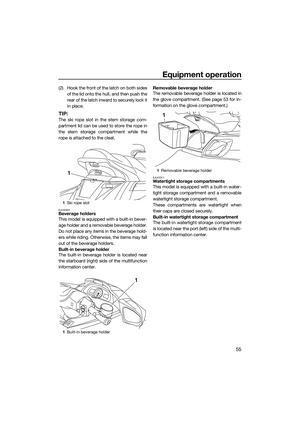 61
61 62
62 63
63 64
64 65
65 66
66 67
67 68
68 69
69 70
70 71
71 72
72 73
73 74
74 75
75 76
76 77
77 78
78 79
79 80
80 81
81 82
82 83
83 84
84 85
85 86
86 87
87 88
88 89
89 90
90 91
91 92
92 93
93 94
94 95
95 96
96 97
97 98
98 99
99 100
100 101
101 102
102 103
103 104
104 105
105 106
106 107
107 108
108 109
109 110
110 111
111 112
112 113
113 114
114 115
115 116
116 117
117


